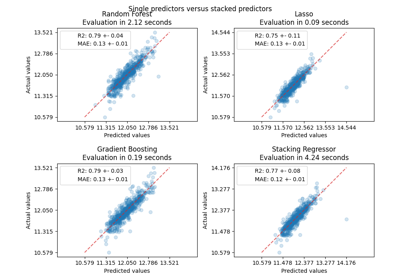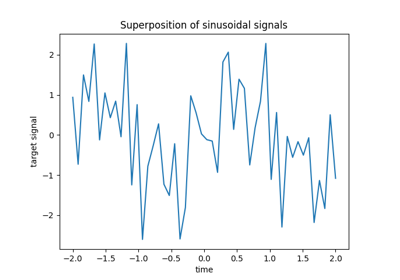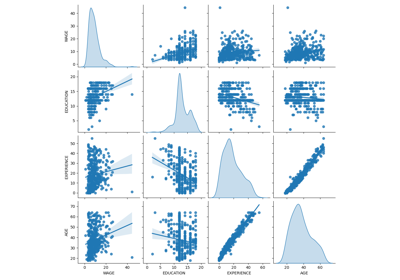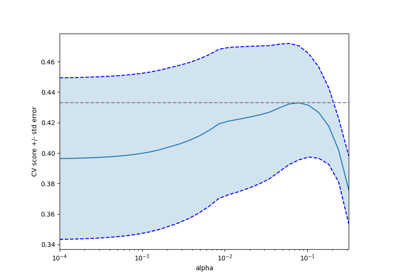LassoCV#
- class sklearn.linear_model.LassoCV(*, eps=0.001, n_alphas=100, alphas=None, fit_intercept=True, precompute='auto', max_iter=1000, tol=0.0001, copy_X=True, cv=None, verbose=False, n_jobs=None, positive=False, random_state=None, selection='cyclic')#
Lasso线性模型沿着正则化路径进行迭代拟合。
请参阅 cross-validation estimator 的词汇条目。
最佳模型通过交叉验证选择。
Lasso的优化目标为:
(1 / (2 * n_samples)) * ||y - Xw||^2_2 + alpha * ||w||_1
更多信息请参阅 User Guide 。
- Parameters:
- epsfloat, default=1e-3
路径的长度。
eps=1e-3意味着alpha_min / alpha_max = 1e-3。- n_alphasint, default=100
沿正则化路径的alpha数量。
- alphasarray-like, default=None
计算模型的alpha列表。如果为
None,则自动设置alpha。- fit_interceptbool, default=True
是否计算此模型的截距。如果设置为 false,则不使用截距进行计算(即数据预期已中心化)。
- precompute‘auto’, bool or array-like of shape (n_features, n_features), default=’auto’
是否使用预计算的Gram矩阵以加速计算。如果设置为
'auto',则由我们决定。Gram矩阵也可以作为参数传递。- max_iterint, default=1000
最大迭代次数。
- tolfloat, default=1e-4
优化的容差:如果更新小于
tol,优化代码检查对偶间隙是否最优并继续直到小于tol。- copy_Xbool, default=True
如果为
True,则复制X;否则,可能会被覆盖。- cvint, cross-validation generator or iterable, default=None
确定交叉验证分割策略。 cv的可能输入为:
None,使用默认的5折交叉验证,
int,指定折数。
一个迭代器,产生 (train, test) 分割为索引数组。
对于int/None输入,使用
KFold。请参阅 User Guide 以了解可以使用的各种交叉验证策略。
Changed in version 0.22:
cv的默认值如果为None,从3折改为5折。- verbosebool or int, default=False
详细程度。
- n_jobsint, default=None
交叉验证期间使用的CPU数量。
None意味着1,除非在joblib.parallel_backend上下文中。-1意味着使用所有处理器。请参阅 Glossary 以获取更多详细信息。- positivebool, default=False
如果为正,则限制回归系数为正。
- random_stateint, RandomState instance, default=None
选择随机特征更新的伪随机数生成器的种子。当
selection== ‘random’ 时使用。 传递一个int以在多次函数调用中重现输出。请参阅 Glossary 。- selection{‘cyclic’, ‘random’}, default=’cyclic’
如果设置为 ‘random’,则每次迭代更新一个随机系数,而不是默认情况下按顺序循环遍历特征。这(设置为 ‘random’)通常会显著加快收敛速度,特别是当 tol 高于 1e-4 时。
- Attributes:
- alpha_float
通过交叉验证选择的惩罚量。
- coef_ndarray of shape (n_features,) or (n_targets, n_features)
参数向量(w在成本函数公式中)。
- intercept_float or ndarray of shape (n_targets,)
决策函数中的独立项。
- mse_path_ndarray of shape (n_alphas, n_folds)
每个折在测试集上的均方误差,随alpha变化。
- alphas_ndarray of shape (n_alphas,)
用于拟合的alpha网格。
- dual_gap_float or ndarray of shape (n_targets,)
优化结束时对于最优alpha(
alpha_)的对偶间隙。- n_iter_int
坐标下降求解器为达到最优alpha的指定容差而运行的迭代次数。
- n_features_in_int
在 fit 期间看到的特征数量。
Added in version 0.24.
- feature_names_in_ndarray of shape (
n_features_in_,) 在 fit 期间看到的特征名称。仅当
X的特征名称为所有字符串时定义。Added in version 1.0.
See also
lars_path使用LARS算法计算最小角回归或Lasso路径。
lasso_path使用坐标下降计算Lasso路径。
LassoLasso是一个估计稀疏系数的线性模型。
LassoLars使用最小角回归(又名Lars)拟合的Lasso模型。
LassoCV沿着正则化路径进行迭代拟合的Lasso线性模型。
LassoLarsCV使用LARS算法的交叉验证Lasso。
Notes
在
fit中,一旦通过交叉验证找到最佳参数alpha,模型将使用整个训练集重新拟合。为了避免不必要的内存复制,
fit方法的X参数应直接传递为Fortran连续的numpy数组。LassoCV导致的结果不同于使用GridSearchCV和Lasso模型进行超参数搜索的结果。在LassoCV中,给定惩罚alpha的模型使用在正则化路径上最接近的模型(在前一次迭代中训练)的系数进行热启动。这往往会加快超参数搜索的速度。Examples
>>> from sklearn.linear_model import LassoCV >>> from sklearn.datasets import make_regression >>> X, y = make_regression(noise=4, random_state=0) >>> reg = LassoCV(cv=5, random_state=0).fit(X, y) >>> reg.score(X, y) 0.9993... >>> reg.predict(X[:1,]) array([-78.4951...])
- fit(X, y, sample_weight=None, **params)#
拟合使用坐标下降法的线性模型。
拟合在alpha的网格上进行,并通过交叉验证估计最佳alpha。
- Parameters:
- X{array-like, sparse matrix} of shape (n_samples, n_features)
训练数据。直接传递为Fortran连续数据以避免不必要的内存复制。如果y是单输出的,X可以是稀疏的。请注意,不接受需要
int64索引的大型稀疏矩阵和数组。- yarray-like of shape (n_samples,) or (n_samples, n_targets)
目标值。
- sample_weightfloat or array-like of shape (n_samples,), default=None
用于拟合和评估每个cv-fold的加权均方误差的样本权重。请注意,最终用于找到最佳模型的交叉验证MSE是每个测试折叠的(加权)MSE的未加权平均值。
- **paramsdict, default=None
传递给CV分割器的参数。
Added in version 1.4: 仅在
enable_metadata_routing=True时可用, 可以通过使用sklearn.set_config(enable_metadata_routing=True)设置。 有关更多详细信息,请参阅:ref:Metadata Routing User Guide <metadata_routing>。
- Returns:
- selfobject
返回一个拟合模型的实例。
- get_metadata_routing()#
获取此对象的元数据路由。
请查看 用户指南 以了解路由机制的工作原理。
Added in version 1.4.
- Returns:
- routingMetadataRouter
一个封装了路由信息的
MetadataRouter。
- get_params(deep=True)#
获取此估计器的参数。
- Parameters:
- deepbool, 默认=True
如果为True,将返回此估计器和包含的子对象(也是估计器)的参数。
- Returns:
- paramsdict
参数名称映射到它们的值。
- static path(X, y, *, eps=0.001, n_alphas=100, alphas=None, precompute='auto', Xy=None, copy_X=True, coef_init=None, verbose=False, return_n_iter=False, positive=False, **params)#
计算Lasso路径使用坐标下降法。
Lasso优化函数对于单输出和多输出任务有所不同。
对于单输出任务,它是:
(1 / (2 * n_samples)) * ||y - Xw||^2_2 + alpha * ||w||_1
对于多输出任务,它是:
(1 / (2 * n_samples)) * ||Y - XW||^2_Fro + alpha * ||W||_21
其中:
||W||_21 = \sum_i \sqrt{\sum_j w_{ij}^2}
即每行的范数之和。
更多信息请参阅 用户指南 。
- Parameters:
- X{array-like, sparse matrix},形状为 (n_samples, n_features)
训练数据。直接传递为Fortran连续数据以避免不必要的内存复制。如果
y是单输出,则X可以是稀疏的。- y{array-like, sparse matrix},形状为 (n_samples,) 或 (n_samples, n_targets)
目标值。
- epsfloat, 默认=1e-3
路径的长度。
eps=1e-3意味着alpha_min / alpha_max = 1e-3。- n_alphasint, 默认=100
沿正则化路径的alpha数量。
- alphasarray-like, 默认=None
计算模型的alpha列表。如果
None,则自动设置alpha。- precompute‘auto’, bool 或 形状为 (n_features, n_features) 的array-like, 默认=’auto’
是否使用预计算的Gram矩阵以加速计算。如果设置为
'auto',则由我们决定。Gram矩阵也可以作为参数传递。- Xy形状为 (n_features,) 或 (n_features, n_targets) 的array-like, 默认=None
Xy = np.dot(X.T, y) 可以预计算。只有在预计算Gram矩阵时才有用。
- copy_Xbool, 默认=True
如果
True,X将被复制;否则,可能会被覆盖。- coef_init形状为 (n_features, ) 的array-like, 默认=None
系数的初始值。
- verbosebool 或 int, 默认=False
详细程度。
- return_n_iterbool, 默认=False
是否返回迭代次数。
- positivebool, 默认=False
如果设置为True,强制系数为正。(仅在
y.ndim == 1时允许)。- **paramskwargs
传递给坐标下降求解器的关键字参数。
- Returns:
- alphas形状为 (n_alphas,) 的ndarray
计算模型的alpha路径。
- coefs形状为 (n_features, n_alphas) 或 (n_targets, n_features, n_alphas) 的ndarray
沿路径的系数。
- dual_gaps形状为 (n_alphas,) 的ndarray
每个alpha优化结束时的对偶间隙。
- n_iterslist of int
坐标下降优化器为达到指定容差所需的迭代次数。
See also
lars_path使用LARS算法计算最小角回归或Lasso路径。
LassoLasso是一个估计稀疏系数的线性模型。
LassoLars使用最小角回归(又名Lars)拟合的Lasso模型。
LassoCV沿正则化路径迭代拟合的Lasso线性模型。
LassoLarsCV使用LARS算法进行交叉验证的Lasso。
sklearn.decomposition.sparse_encode估计器,可用于将信号转换为固定原子的稀疏线性组合。
Notes
有关示例,请参见 examples/linear_model/plot_lasso_coordinate_descent_path.py 。
为了避免不必要的内存复制,fit方法的X参数应直接传递为Fortran连续的numpy数组。
请注意,在某些情况下,Lars求解器可能会显著更快地实现此功能。特别是,可以使用线性插值来检索lars_path输出值之间的模型系数。
Examples
比较lasso_path和lars_path与插值:
>>> import numpy as np >>> from sklearn.linear_model import lasso_path >>> X = np.array([[1, 2, 3.1], [2.3, 5.4, 4.3]]).T >>> y = np.array([1, 2, 3.1]) >>> # 使用lasso_path计算系数路径 >>> _, coef_path, _ = lasso_path(X, y, alphas=[5., 1., .5]) >>> print(coef_path) [[0. 0. 0.46874778] [0.2159048 0.4425765 0.23689075]]
>>> # 现在使用lars_path和1D线性插值计算相同的路径 >>> from sklearn.linear_model import lars_path >>> alphas, active, coef_path_lars = lars_path(X, y, method='lasso') >>> from scipy import interpolate >>> coef_path_continuous = interpolate.interp1d(alphas[::-1], ... coef_path_lars[:, ::-1]) >>> print(coef_path_continuous([5., 1., .5])) [[0. 0. 0.46915237] [0.2159048 0.4425765 0.23668876]]
- predict(X)#
使用线性模型进行预测。
- Parameters:
- Xarray-like 或 sparse matrix, shape (n_samples, n_features)
样本。
- Returns:
- Carray, shape (n_samples,)
返回预测值。
- score(X, y, sample_weight=None)#
返回预测的决定系数。
决定系数 \(R^2\) 定义为 \((1 - rac{u}{v})\) ,其中 \(u\) 是残差平方和
((y_true - y_pred)** 2).sum(),而 \(v\) 是总平方和((y_true - y_true.mean()) ** 2).sum()。最好的可能得分是 1.0,它可能是负的(因为模型可能任意地差)。一个总是预测y的期望值的常数模型,忽略输入特征,将得到 \(R^2\) 得分为 0.0。- Parameters:
- Xarray-like of shape (n_samples, n_features)
测试样本。对于某些估计器,这可能是一个预计算的核矩阵或一个形状为
(n_samples, n_samples_fitted)的通用对象列表,其中n_samples_fitted是估计器拟合中使用的样本数量。- yarray-like of shape (n_samples,) or (n_samples, n_outputs)
X的真实值。- sample_weightarray-like of shape (n_samples,), default=None
样本权重。
- Returns:
- scorefloat
\(R^2\) 相对于
y的self.predict(X)。
Notes
在调用回归器的
score时使用的 \(R^2\) 得分从 0.23 版本开始使用multioutput='uniform_average'以保持与r2_score默认值一致。 这影响了所有多输出回归器的score方法(除了MultiOutputRegressor)。
- set_fit_request(*, sample_weight: bool | None | str = '$UNCHANGED$') LassoCV#
Request metadata passed to the
fitmethod.Note that this method is only relevant if
enable_metadata_routing=True(seesklearn.set_config). Please see User Guide on how the routing mechanism works.The options for each parameter are:
True: metadata is requested, and passed tofitif provided. The request is ignored if metadata is not provided.False: metadata is not requested and the meta-estimator will not pass it tofit.None: metadata is not requested, and the meta-estimator will raise an error if the user provides it.str: metadata should be passed to the meta-estimator with this given alias instead of the original name.
The default (
sklearn.utils.metadata_routing.UNCHANGED) retains the existing request. This allows you to change the request for some parameters and not others.Added in version 1.3.
Note
This method is only relevant if this estimator is used as a sub-estimator of a meta-estimator, e.g. used inside a
Pipeline. Otherwise it has no effect.- Parameters:
- sample_weightstr, True, False, or None, default=sklearn.utils.metadata_routing.UNCHANGED
Metadata routing for
sample_weightparameter infit.
- Returns:
- selfobject
The updated object.
- set_params(**params)#
设置此估计器的参数。
该方法适用于简单估计器以及嵌套对象(例如
Pipeline)。后者具有形式为<component>__<parameter>的参数,以便可以更新嵌套对象的每个组件。- Parameters:
- **paramsdict
估计器参数。
- Returns:
- selfestimator instance
估计器实例。
- set_score_request(*, sample_weight: bool | None | str = '$UNCHANGED$') LassoCV#
Request metadata passed to the
scoremethod.Note that this method is only relevant if
enable_metadata_routing=True(seesklearn.set_config). Please see User Guide on how the routing mechanism works.The options for each parameter are:
True: metadata is requested, and passed toscoreif provided. The request is ignored if metadata is not provided.False: metadata is not requested and the meta-estimator will not pass it toscore.None: metadata is not requested, and the meta-estimator will raise an error if the user provides it.str: metadata should be passed to the meta-estimator with this given alias instead of the original name.
The default (
sklearn.utils.metadata_routing.UNCHANGED) retains the existing request. This allows you to change the request for some parameters and not others.Added in version 1.3.
Note
This method is only relevant if this estimator is used as a sub-estimator of a meta-estimator, e.g. used inside a
Pipeline. Otherwise it has no effect.- Parameters:
- sample_weightstr, True, False, or None, default=sklearn.utils.metadata_routing.UNCHANGED
Metadata routing for
sample_weightparameter inscore.
- Returns:
- selfobject
The updated object.






